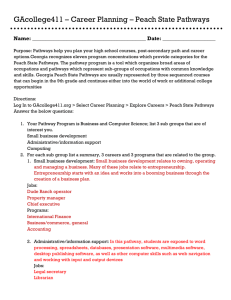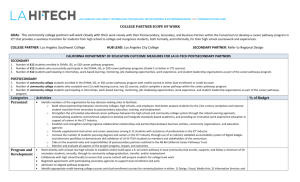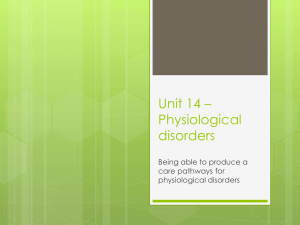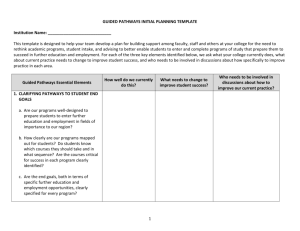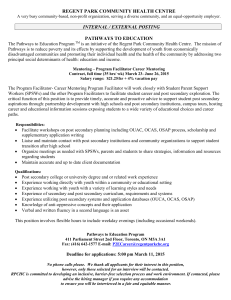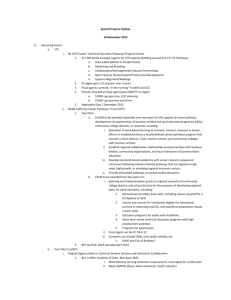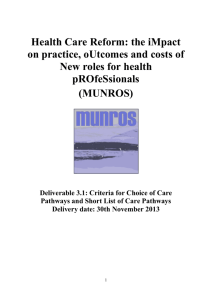DRAFT Pathways to Prosperity Examples for Inclusion in Your
advertisement
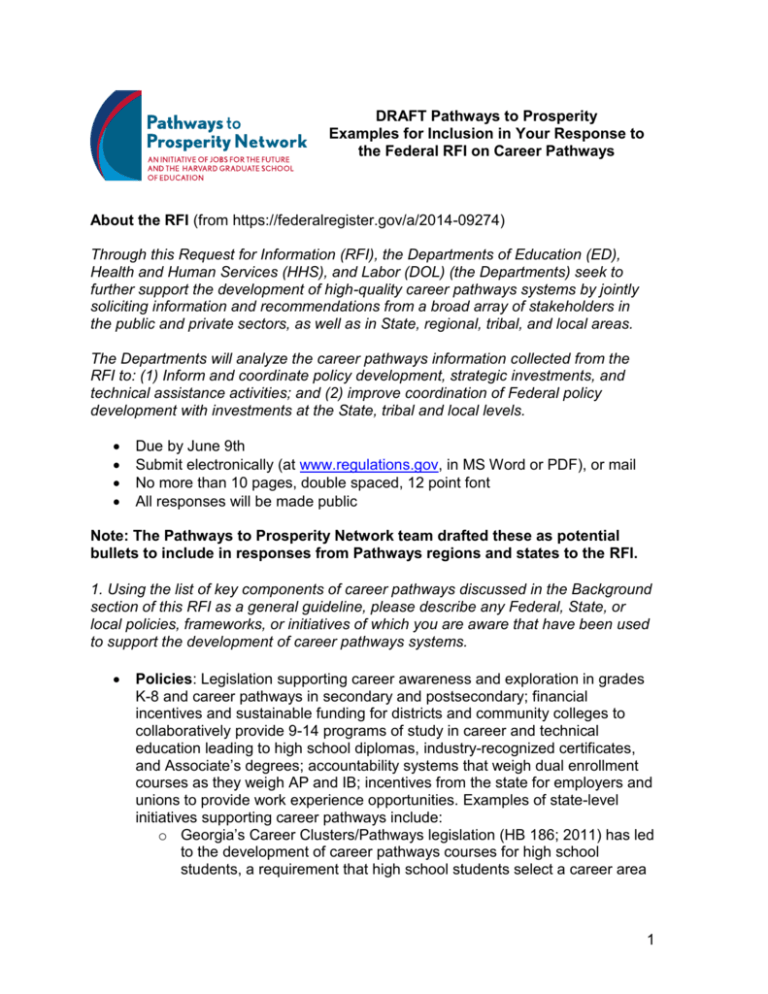
DRAFT Pathways to Prosperity Examples for Inclusion in Your Response to the Federal RFI on Career Pathways About the RFI (from https://federalregister.gov/a/2014-09274) Through this Request for Information (RFI), the Departments of Education (ED), Health and Human Services (HHS), and Labor (DOL) (the Departments) seek to further support the development of high-quality career pathways systems by jointly soliciting information and recommendations from a broad array of stakeholders in the public and private sectors, as well as in State, regional, tribal, and local areas. The Departments will analyze the career pathways information collected from the RFI to: (1) Inform and coordinate policy development, strategic investments, and technical assistance activities; and (2) improve coordination of Federal policy development with investments at the State, tribal and local levels. Due by June 9th Submit electronically (at www.regulations.gov, in MS Word or PDF), or mail No more than 10 pages, double spaced, 12 point font All responses will be made public Note: The Pathways to Prosperity Network team drafted these as potential bullets to include in responses from Pathways regions and states to the RFI. 1. Using the list of key components of career pathways discussed in the Background section of this RFI as a general guideline, please describe any Federal, State, or local policies, frameworks, or initiatives of which you are aware that have been used to support the development of career pathways systems. Policies: Legislation supporting career awareness and exploration in grades K-8 and career pathways in secondary and postsecondary; financial incentives and sustainable funding for districts and community colleges to collaboratively provide 9-14 programs of study in career and technical education leading to high school diplomas, industry-recognized certificates, and Associate’s degrees; accountability systems that weigh dual enrollment courses as they weigh AP and IB; incentives from the state for employers and unions to provide work experience opportunities. Examples of state-level initiatives supporting career pathways include: o Georgia’s Career Clusters/Pathways legislation (HB 186; 2011) has led to the development of career pathways courses for high school students, a requirement that high school students select a career area 1 to explore, and a great deal of work across sectors to align career pathways. o In North Carolina, the Career and College Promise initiative ensures that college credits earned in high school are transferable to all institutions in the University of North Carolina system. The state restructured its dual enrollment programs by creating defined and coherent pathways for students. Eligible high school juniors and seniors who participate in dual enrollment must select a specific program of study: a college transfer pathway, a technical career pathway, or enroll in early college. The primary goal of CCP is to accelerate a students' completion of college credentials, certificates and two-and-four-year degrees. Dual Enrollment: Based on JFF’s work with early college high schools as well as our Pathways to Prosperity Network, we believe that supportive policies and practices in dual enrollment are critical to career pathways. Below are JFF’s policy recommendations regarding dual enrollment: o ELIGIBILITY AND ACCESS: States should broaden eligibility requirements to permit students to participate in credit-bearing, college-level courses based on proficiency in those subjects even if they are not proficient in others. Student eligibility should also be determined by multiple measures: a combination of tests, end-ofcourse grades, teacher recommendations, and students’ work portfolios. o QUALITY ASSURANCE: States should ensure that college courses offered to high school students use the same syllabi and exams as comparable courses taught on a college campus, and that dual enrollees can receive dual credit so they earn both high school and college credits upon successfully completing courses. In addition, the postsecondary institution conferring credit should set the qualifications for faculty teaching courses taken for dual credit. o SUSTAINABLE FUNDING AND FINANCE: States should develop funding policies that allow high school students to take college courses free of tuition and non-course-related charges, and that allow both districts and postsecondary institutions to claim per pupil funding allocations to support the cost of offering college courses for dual credit. There should also be provisions or special appropriations to support the development of early college models targeting students who are underrepresented in higher education. o SYSTEM FOR ACCOUNTABILITY: States should report annually on dual enrollment participation and impact and develop administrative structures to support program leaders and dual enrollment partnerships. States should also designate a state board or governing body as having the authority and responsibility to guide dual enrollment policy. 2 o ALIGNED DATA SYSTEMS: States should develop unit-record statewide data systems that identify dual enrollees by demographic characteristics and monitor student progress longitudinally across the K-12 and higher education systems. o ACADEMIC AND SOCIAL SUPPORTS: States should require that districts and postsecondary institutions specify and document key roles and responsibilities in memoranda of understanding or cooperative agreements, including the provision of a college liaison for student advisement and support. States should also provide support and funding for programs designed to serve students who are overage and under-credited and youth who have dropped out of high school. Pathways to Prosperity Framework: The foundational building block of the Pathways to Prosperity Network is a grades 9-14 career pathway that integrates high school and college-level work—for example, a career academy or a comprehensive program of study that includes all the requirements for completing a high school diploma and a postsecondary credential with value in the labor market. The network develops 9-14 career pathways systems through four strategic implementation levers: early and sustained career information and advising systems; employer engagement; effective intermediaries; and state leadership/enabling state policies. o 9-14 Career Pathways: High schools and community colleges create 9-14 career pathways, with clear structures, timelines, costs, and requirements linking and integrating high school and postsecondary curricula and aligning both with labor market requirements. o Career Information/Advising: Starting in the middle grades, students are exposed to a wide range of career options, information, and opportunities to learn about high school and postsecondary courses of study leading to careers. o Employer Engagement: Employers commit to providing a continuum of learning opportunities at the workplace throughout the 9-14 pathway. Employers collaborate with educators and are supported by intermediaries in structuring and managing workplace learning. Employers support students’ transitions into the local labor market. o Effective Intermediaries: Local or regional intermediaries serve as conveners, brokers, and technical assistance providers to schools and employers engaged in building and sustaining pathways. Intermediaries recruit business, nonprofit, and public employers and ensure that participating leaders understand and support the vision. o State Leadership and Policy: State dual enrollment policies provide access to postsecondary education for low-income students. Districts and community colleges have financial incentives and sustainable funding to provide 9-14 programs of study in career and technical education leading to diplomas, certificates, or Associate’s degrees. Accountability systems weigh dual enrollment courses as they weigh 3 AP and IB. The state provides incentives for employers and unions to provide work experience opportunities. 2. What factors, in your opinion, have facilitated the implementation of career pathways systems at the State or local level (e.g., the use of key resources or technical assistance tools)? What factors have made career pathways systems difficult to implement and/or replicate on a large scale? Factors that have facilitated implementation: Active partnership and shared goals, metrics, and braided funding across state agencies (K-12, higher education, labor and workforce development, economic development, others). Ongoing collaboration amongst state leaders focused on aligning the education and workforce systems to link students, job seekers, and employers to career pathways that respond to local and global high-demand, high-growth, high-wage opportunities. These relationships can be formalized through Intergovernmental Agreements, P-20 Councils, Pathways Steering Committees, Memoranda of Understanding, and/or other working groups, and they should include executive leadership from K-12, vocational and technical education, adult basic education, and postsecondary education, as well as employers, workforce development, and economic development leaders. Similar collaborative work groups at the regional level comprised of crosssectoral leadership. Investment by state departments of education (and local districts and colleges)—in the form of financial resources and/or staff—to plan, implement, expand, and/or support career pathways systems across the state. History of dual enrollment funded by the state and serving successfully a wide range of students Pressure to improve postsecondary completion rates Employer advocacy for education to respond to skills gaps Factors that have made career pathways systems difficult to implement: Absence of dual enrollment funding and legislation Limited staff and limited capacity at the state and local levels to plan, implement, and own the work. Difficulty securing funding to launch and sustain the pathway planning and course development work that crosses K-12 and higher education. Engaging business partners who will be full partners in the pathway development, including allowing teenagers into the workplace. Competition between districts and schools to engage employers without the use of an entity to aggregate, coordinate, and distribute opportunities Need for extensive technical assistance to implement locally and go to scale. Need for a mindset shift among parents, teachers, and students around the value of career and technical education to dispel concerns about tracking. 4 3. What Federal, State, or local governmental and non-governmental funding streams are you aware of that have been used to support career pathways initiatives? If applicable, to what extent is your State or local area aligning or braiding funding from across different funding streams to support career pathways? Please describe facilitators and/or challenges to aligning and braiding funding. If you are not aligning and/or braiding funding, please describe any specific barriers. Innovation Campus High School Grants: In February 2013, three high schools in St. Louis participating in the Pathways to Prosperity pilot (St. Louis Public Schools, Pattonville School District, and Ferguson-Florissant) were awarded $1.3 million in Community Development Block Grant funds from Governor Jay Nixon to establish Innovation High Schools. With these funds, districts were required to partner with local businesses and the St. Louis Community College to provide opportunities for students to earn college credit and gain hands-on experience in high-demand fields such as advanced manufacturing, skilled trades, health sciences, and information technology. California Pathways Trust: Funds in the amount of $249,750,000 were appropriated as part of Assembly Bill 86, Chapter 48, Statues of 2013, for the establishment of kindergarten through community college (K–14) career pathways programs in the form of one-time competitive grants available for the 2014–15 fiscal year through the 2017–18 fiscal year. Overseen by the California Department of Education, awardees will target K–14 career pathway programs that provide students with a sequenced pathway of integrated academic and career-based education and training, aligned to current or emerging regional economic needs. Ohio Straight A Fund: This $250 million innovative grant project was created by Governor John R. Kasich in summer 2013 from lottery revenue. During the first round, 24 grants representing over 150 school districts and partnering organizations were awarded 88.6 million, including a $14.4M grant for Pathways to Prosperity in Central Ohio. The Ohio Department of Education is now reviewing applications for the second round of awards for FY15. Race to the Top: Illinois used $3.2 million in Race to the Top funding to create Illinois Pathways, which brings together partners from education, business, and industry to provide early college and work-based learning opportunities to high-school students in 9 STEM career clusters. 4. For your career pathways system, please describe the roles and responsibilities of each of the following partners with whom you work (please answer only for those that are applicable). What factors facilitate and/or create obstacles to successful partnership efforts? a. Businesses/employers and industry associations Form a strong collaboration, documented in a formal agreement, with secondary, postsecondary, and other community partners; 5 Commit to provide all students enrolled in a career pathway an opportunity to participate in some form of workplace learning, including job shadowing, paid or unpaid internships, virtual and group experiences, and paid part-time and/or summer employment; Partner with educators to create an up-to-date skills map for the industry/sector that identifies essential job requirements and competencies; Provide workplace visits, speakers, and mentors for participating students and externships for teachers and community college faculty as appropriate; Collaborate with LEA and postsecondary staff to align technical skills and workplace competencies with curriculum, course offerings, and other resources; and Provide dedicated staff to work on the career pathways program including an Industry Liaison who has the authority to coordinate with the school on the business partners’ behalf. b. Education providers (e.g. K-12 education, special education, institutions of higher education including but not limited to community and technical colleges, and/or other training providers) K-12 Form a strong collaboration, documented in a formal agreement, with postsecondary, business, and any other community partners; Develop a formal decision-making structure including identifying key leaders from each sector; Recruit a student cohort broadly representative of the overall school population, including students with special needs for enrollment in the career pathway; Identify potential school leaders who have demonstrated the ability to drive student outcomes; can provide the leadership skills essential for program success; and can integrate high school, college, and workbased learning experiences; Provide dedicated staff to work on the career pathways program who have the authority to coordinate with postsecondary education on the LEA’s behalf; Work with higher education, workforce development entities, and industry partners to develop seamless transitions for students into postsecondary education, employment, and or training; Establish opportunities for all students to: o Accelerate into community college courses while still in high school. o Participate in appropriately sequenced work-place experiences to make informed choices among postsecondary options. o Develop personal dispositions such as time management, collaboration, problem-solving, leadership, study skills, 6 communication, and analytical skills, which are required for success in the workplace. Provide relevant and ongoing professional development for administrators, and all participating teachers/instructors, including support and frequent opportunities for reflection and collaboration during the school year. Postsecondary Identify appropriate credit-bearing college courses and dual enrollment courses in a career pathway to prepare students to enter postsecondary without need for remediation; Collaborate with the secondary partner(s) to determine which courses will be taught by college faculty, by high school teachers with adjunct status, or by a combination of the two (ensuring the appropriate collegelevel rigor of courses taught by adjunct faculty) leveraging dual enrollment, credit recognition on e-transcript, and credit-by-exam policies in support thereof; Collaborate with high school faculty to ensure that course content will prepare students for college level work; Negotiate agreements with participating secondary agencies to support dual enrollment and early admission to aligned pathway programs; Collaborate with business partners to align college coursework with relevant technical skills and workplace competencies, as defined by industry; Maintain student advisory resources and credit transfer policies that protect the pathway to degree completion for participating students; Commit to maximize available funding streams (in addition to grant funding), to support the needs of participating students; Provide dedicated staff to work on the career pathways program who has the authority to coordinate with the LEA on the college/university partner’s behalf; and Leverage, connecting and building upon existing investments in education and workforce development. c. Workforce development agencies (e.g. Workforce Investment Boards and American Job Centers) Designate a primary point person within the WIB to serve as a liaison and active participant for the initiative. Identify employers in industry to partner with the initiative to ensure workbased learning experiences for participating students. Work collaboratively with these organizations to coordinate their engagement in program activities and events for participating students. Work collaboratively with faculty at participating schools to create integrated classroom activities focused on work-based experiences and provide opportunities for students and teachers to visit partnering health care employers and other related companies to obtain information and 7 resources on work-based learning that can be embedded into the career pathways program. Promote and market the pathways program to other organizations in the industry in order to strengthen and broaden industry engagement along the grade 9-14 pathway. Attend and participate in team meetings. d. Community-based organizations and human service providers that address barriers to employment (e.g. cash assistance/TANF, child care, transportation, housing, food assistance/SNAP, etc.) e. Philanthropic organizations/intermediaries Serve as the facilitator and convener of on-going strategic planning, program development, partnership enhancement, and program implementation for collaborative career pathway initiatives—such as Pathways to Prosperity. Provide a dedicated liaison as well as access to other team members with a variety of areas of expertise to provide just-in-time consultation to regional leads Advise the regional development of a twelve-month pathways work plan aligned with the Pathways levers and informed by asset mapping and relevant education and labor market data Convene and consult with regional planning teams as they design and implement strategies around each of the Pathways levers Adapt and create as-needed tools and materials for regional use Meet at least quarterly—by phone or in person—with regional leads to discuss progress on work plan and to identify any areas needing JFF technical assistance Conduct at least two site visits per year to observe and provide feedback and support regarding pathway development and implementation Work with the region to develop a communications and marketing strategy to make the work visible to interested parties and to rally community support of the work Communicate and coordinate regional work with the state, other regions in the state, and the Network overall f. State, regional, local, and/or tribal government agencies Provide leadership and guidance to agencies in connecting and aligning goals and efforts around career pathways. Assist in and support cross-sectoral convenings and collaborations (e.g.: provide staff, venues, visibility). Integrate career pathways and its corresponding elements—such as dual enrollment, youth employment, and employer-education partnerships—into the agency’s strategic planning and public agenda. 8 g. Other (please describe) Local or regional intermediaries, which serve as conveners, brokers, and technical assistance providers to schools and employers, play a pivotal role in the development of strong pathways systems. Intermediaries build and sustain cross-sectoral partnerships, recruit employers, and ensure that participating leaders in partner organizations and institutions understand and support the pathways vision. There are two key sets of intermediary functions. A single intermediary may take on both sets of functions, or the functions may be distributed across multiple organizations. The two sets are: o Anchor functions: holding the vision, convening key stakeholders, and establishing an accountability structure, which includes overseeing a leadership entity of key education, civic, employer, and community leaders who form a collaborative decision-making body o Work-based learning functions: representing employers, linking labor-market organizations, employer organizations, and education and community institutions, creating and supporting career awareness and exploration and work-based learning opportunities for students 5. Is your career pathways system connected to a State, regional, local, or tribal economic development strategy? If so, how? Pathways to Prosperity connects career pathways to economic development strategies through the use of traditional and real-time labor market information, asset mapping, and conversations with employers, activities that generally align well with those of economic development organizations. The development of career pathways can make a substantial contribution to local and regional economic development efforts in two ways. First, by preparing young people and workers for family-sustaining careers in fields aligned with local labor-market demand, career pathways help ensure that regions are able to retain workers with money to spend in local and regional economies. Second, the existence of a skilled workforce in a particular region can help attract new employers to the area. 6. How do you ensure that your career pathways system is staying current with labor market trends, particularly current demand, to respond to the need for particular skills and credentials in emerging industry sectors? Using state and regional long-term projections for a 10-year period, sites identify high-skill, high-wage, high-growth jobs—and the credentials that lead to them—in industry sectors that drive the regional economy. Sites, along with their community college partners, revisit the projections periodically in order to ensure that their course offerings are aligned with the needs of the labor market. 9 Before developing a work plan for the creation of career pathways in a region, Pathways to Prosperity conducts asset mapping in the region. The assetmapping process, which includes conversations with employers and in-depth analysis of real-time and traditional LMI (including EMSI, Burning Glass, and BLS), helps to identify regional labor-market trends, including demand for particular skills and credentials. 7. How can career pathways systems be made accessible to diverse populations and responsive to their needs beyond education and training (e.g., support services such as childcare, transportation, housing, etc.)? We are particularly, but not exclusively, interested in learning about efforts to serve low-income youth and adults, low-skilled youth and adults, out-of-school youth, individuals with disabilities, TANF recipients, tribal communities, English language learners, immigrants, rural populations, veterans, currently and formerly incarcerated individuals, dislocated workers, and trade-affected workers. From Jobs for the Future’s description of our work: Preparing for College and Career Our country must enable more low-income and minority students to earn a high school diploma and graduate ready for college. Only 65 percent of low-income youth are graduating from high school today, compared with 87 percent of higher-income students. The dropout rate for low-income students is estimated to be 10 times higher than for their peers. This means that too few youth in America are earning a high school credential that is a critical step along the road to valuable postsecondary credentials and, ultimately, a family-supporting career. Even many who do graduate need better preparation to begin and complete that postsecondary work. JFF’s school designs combine high school and college in rigorous, supportive environments through dual enrollment, early college high schools, bridge programs, GED-to-college programs for out-of-school youth, and career and technical education pathways. The related instructional models engage and motivate even struggling students, putting them on track to succeed in the future. Earning Postsecondary Credentials Too many youth and adults do not have the knowledge and skills needed to enter postsecondary education or earn college credits, and lower-skilled students who do enroll then face barriers to earning a credential. Sixty percent of students who enter community college are academically underprepared and required to take developmental courses, paying tuition before earning college credit. Only about one-quarter of first-time community college students—and even fewer low-income and minority students—attain a degree or certificate within five years. JFF has identified evidence-based best practices for enabling students to earn credentials that are of value in the labor market. Our programs provide student supports, especially in the first year, which can make the difference between persistence and dropping out. We build contextualized career 10 pathways that empower students to learn basic skills while participating in career-specific training at the same time. Real-time labor market information is used to connect education and training programs with current employer needs, and help colleges guide students into pathways that match their interests with local demand. Advancing Careers and Economic Growth Too many adults do not have the knowledge and skills needed to obtain family-supporting careers. Ninety-three million adults, or more than 30 percent of U.S. workers, have such low literacy, math, and occupational skills that they cannot find decent work at decent wages or access further education and job training. By 2016, two-thirds of jobs will require some postsecondary education. This is an untenable situation for workers, employers, and the economy. JFF designs and implements innovative approaches to the education and training of low-skilled adults, such as work-based learning, tied to the needs of regional employers. Our programs focus on sectors that offer familysupporting wages and advancement opportunities. We foster employer partnerships and workforce development in these sectors of high economic growth. All Key Strategies for Pathways Serving Diverse Populations Acceleration: Students or trainees learn more material in less time, which engages their interest and increases their chance of obtaining a credential. Contextualization: Instructors teach skills in the context that students will use them in their daily lives or in jobs that they're pursuing. Scalability: Evidence-based and promising practices should have the ability to be replicated in other institutions and communities. 8. Which populations would you like to serve, but are unable to serve or face special challenges in serving? What are the barriers to serving these particular populations and what are the strategies, recommendations, or lessons learned that can be used to achieve positive outcomes in serving these populations? The Pathways to Prosperity Network is designed to serve most students in comprehensive high schools. However, a challenge in the work is the ongoing marginalization of CTE programs and the tendency to conflate pathways work with older CTE models. In order to overcome this challenge, we will need to work to change mindsets around this work by showing how career pathways can open up options for all students, not just those who may not pursue bachelor’s degrees directly out of high school. Students in low-income rural areas where there are few job openings and transportation is a challenge are particularly challenging to serve, and yet these are the young people who, while they may stay in school, are at risk of floundering once they complete high school. While not now widely available, online resources can help as can putting in place school-based enterprises. 11 9. What are the challenges and/or facilitators to building and/or offering stackable and portable, industry-recognized credentials? How can these industry-recognized credentials be incorporated into and/or aligned in a successful career pathways system? The primary challenge is that high schools do not typically offer industryrecognized credentials. In order to change this, much work would need to be done to map industry-recognized credentials to existing learning outcomes. No marketplace to compare credentials 10. How are participants' outcomes measured, and to what extent are the data used to monitor and improve the strength of your career pathways system? Please indicate if there are any other data points or ongoing evaluation efforts used to improve the strength of your career pathways system. Need to create a flag or an alternate plan to follow the outcomes of pathways students within district and state student information systems. Attendance rate – the rate of school attendance by participants in the program Chronic absence rate – the percentage of participants who have missed 10% of school days for any reason (excused or unexcused), including suspensions Yearly program retention rate – the percentage of participants who continue in the program from one school year to the next Work readiness – percentage of participants who are deemed work ready based on an employer evaluation conducted at the end of each internship or work experience Internship placement and completion rates – the percentage of program participants who begin an internship and, of those who do, the percentage who complete o Average post-secondary credit hours attained – the average number of post-secondary credits attained per participant while in the program o Number of participants in a pathway o Number of participants completing all courses in the pathway o Number of participants receiving a CTE certificate o Number of participants receiving a high school diploma o Number of participants completing dual enrollment or credit by exam o Number of participants receiving an associate’s degree o Number of participants who transition from 2-year to 4-year college o Number of participants entering employment or training in middle skill jobs or higher o College enrollment rate o College persistence rate o College completion rate 12 11. How do performance measures associated with specific Federal funding statutes/streams (i.e., WIA, Perkins, TANF, etc.) facilitate or impede the tracking of participant outcomes? 12. Do you have any suggestions for how Federal, State, regional, tribal, and local governments could support the development of high-quality career pathways systems and/or address gaps in current efforts? If so, please describe the specific changes that would be necessary in each of the following categories (please answer only for those that are applicable): a. Legislation, statutes and/or regulations; for example, (i) Administrative flexibility (i.e., waivers on use of funds or program eligibility) (ii) Expanded eligibility for financial aid and/or other support services (iii) Changes to performance measurement and program accountability rules to include measures of career readiness and to honor students’ work-based learning o State dual enrollment policies provide access to postsecondary education for low-income students o Districts and community colleges have financial incentives and sustainable funding to provide 9-14 programs of study in career and technical education leading to diplomas, certificates, or Associate’s degrees o Accountability systems weigh dual enrollment courses as they weigh AP and IB o The state provides incentives for employers and unions to provide work experience opportunities b. Technical assistance activities and/or non-regulatory guidance; How to truly integrate core academics with applied skills. Alignment with Postsecondary Credit: Understanding the logistics and requirements at the postsecondary level in awarding college credit to secondary students. Making sure the right people are at the table when aligning the curriculum. How to measure growth and effectiveness. Technical assistance, such as the creation of handbooks and toolkits, for employers that deepens their engagement in the work and helps them understand how to create meaningful work-based learning opportunities for young people. c. Funding strategies; A hold-harmless state finance model that allows both high schools and community colleges to claim apportionment for dual enrollment students. Ensure costs for college textbooks and transportation are an allowable use of state funds. 13 In Tennessee, dual enrollment students are eligible to apply for a Dual Enrollment Grant funded by lottery proceeds. The grant covers tuition for lower-division courses only. State, local and institutional support through grants or blended/braided funding streams will ease and systematize grades 9-14 career pathways. Policies to be considered include the utilization of Perkins Funds. d. Research and evaluation activities; e. Other proposed changes. Increased support, including funding, for the development of intermediary organizations that can bring partners together and align the work in order to support the development of strong pathways systems. 13. For business and industry respondents only, please indicate what successes and/or challenges you have faced at local, State, regional, and/or national levels when developing a pipeline of workers. What strategies would you suggest to sustain the successes and/or mitigate the challenges? Developing strong partnerships, which are brokered by intermediary organizations, with educational institutions have led to success in developing a talent pipeline of workers with skills and credentials aligned with labor-market needs. A challenge in providing work-based learning opportunities is that regulations may bar students under the age of 18 from some workplaces. This challenge can be mitigated if employers work with classroom teachers to develop problem-based learning strategies to engage students in solving actual challenges faced by employers. A challenge for employers in advanced manufacturing is that parents and students may have an outdated notion of manufacturing jobs. Efforts to educate the public about advanced manufacturing, such as offering facility tours, can mitigate this challenge. 14

